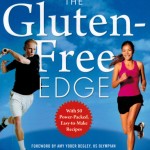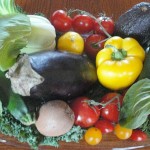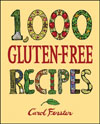Ever wonder what the Olympic athletes REALLY eat to get that competitive edge? Coverage of the Olympics has given us a glimpse into the diets of high-powered athletes like Michael Phelps, Ryan Lochte, and Missy Franklin. But what about the athletes who must be gluten-free, such as Olympic gold medal swimmer Dana Vollmer or other athletes who voluntarily choose a gluten-free diet for faster recovery, reduced inflammation, and overall better performance?
An excellent new book, The Gluten-Free Edge, by Melissa McLean Jory and Peter Bronski, explains how a gluten-free diet delivers that edge.
But you don’t have to be an athlete to benefit from their advice. As I read through this fantastic book, complete with 50 super-healthy recipes, my non-athletic mind kept asking, “What do I eat to stay healthy?” My answer: my daily smoothie.
Gluten-Free Smoothies
Smoothies are a great way to pack lots of health into a glass. You choose what goes into it: for me, that’s mostly vegetables (see the
photo), supplemented with fruit for sweetness plus liquids like juice or milk and then some grains, beans, yogurt, and protein powder….a smoothie so rich in antioxidants, vitamins, and nutrients that my body craves it when I miss a day. My smoothies have been so varied (translation: unusual) that my husband has learned to stop asking, “What’s in this?” and just drink it. As long as it tastes good, he’s OK.
I don’t follow a recipe, but the list below shows what goes into my daily smoothie during the course of a week, depending on what’s in my fridge and freezer. I don’t use all of these foods at one time and I don’t measure them, but I try to cycle weekly through this list to make a 2 to 3-cup smoothie that feeds two people. For example, this morning’s smoothie was kale, beets, carrots, banana, frozen cherries, cultured coconut milk, pomegranate juice, yellow pea protein powder, chia seeds, cinnamon, and soy milk. It all goes into my super-powerful VitaMix blender and in seconds I have a nutritious start to my day. Try it for yourself and use the foods that work for you. Enjoy!!
Smoothie Ingredients
Vegetables
Beets: canned beets are fine
Broccoli: toss in spears/florets raw or uncooked
Carrot: baby carrots are already peeled; just toss them in
Celery: good source of potassium.
Kale: I prefer Tuscan or dinosaur (baby spinach works too)
Parsley: adds chlorophyll and a nice fresh taste
Fruits
Apple (unpeeled): any variety works
Banana: keep peeled frozen bananas in the freezer and use one-half for each smoothie
Berries: usually blueberries, raspberries, cherries, or strawberries
Protein Powder and Flavorings
I alternately use hemp, rice, yellow pea, or soy protein powder
Cinnamon: a quarter-teaspoon adds flavor and helps balance blood sugar
Cocoa: for those days when I absolutely, positively must have chocolate
Milk and Juices
Coconut water: provides potassium and nice flavor
Kefir: cultured coconut milk, for probiotics (can also use yogurt)
Milk: almond, coconut, hemp, or soy all work well and add important calcium (make sure it’s fortified)
Pomegranate or cherry juice: both add terrific flavor and lots of antioxidants
Beans, Grains and Nuts (they thicken the smoothie, so more liquid may be necessary.
Beans (canned is OK but rinse thoroughly): so important for protein, fiber and B-vitamins.
Grain: Amaranth, teff, quinoa, kaniwa (baby quinoa), rolled oats.
Nuts and seeds: almonds, walnuts, pecans, chia seeds, hemp seeds, and flaxseed.









